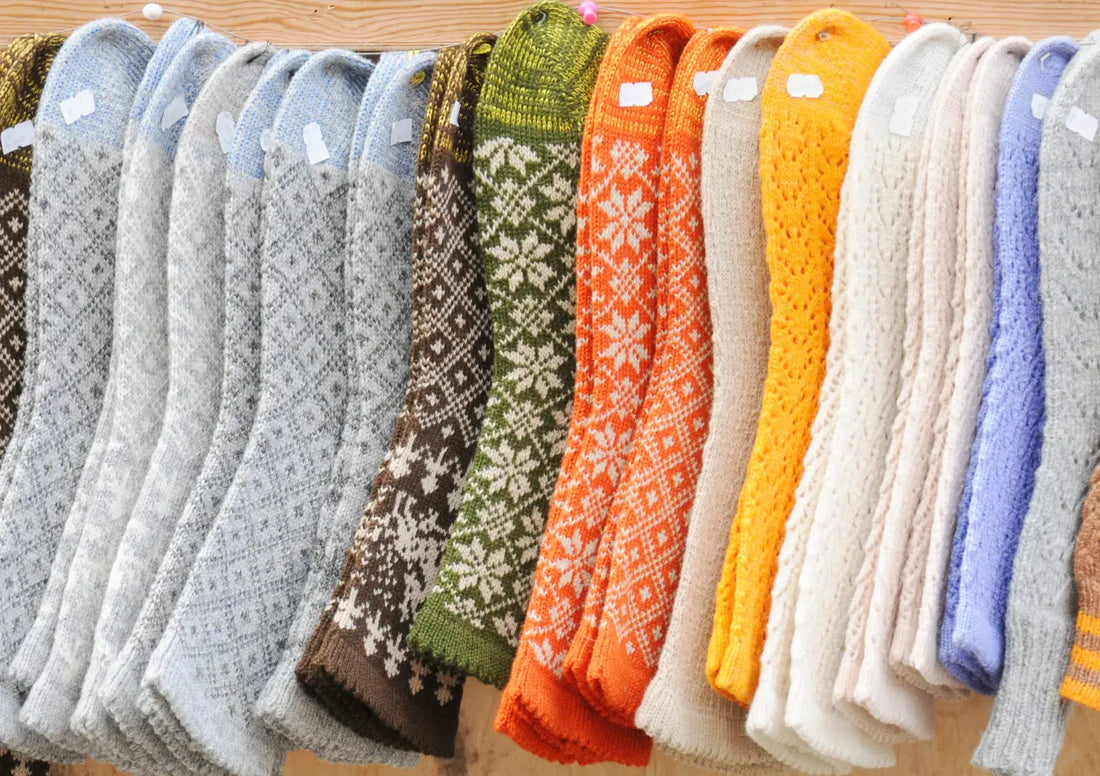
How Compression Socks Enhance Diabetic Foot Care
Share
Diabetes can lead to serious foot issues, making it important for patients to take special care of their feet. Compression socks are a helpful tool in managing these problems. They not only improve blood flow but also provide support and comfort. In this article, we will explore how compression socks can benefit those with diabetes, helping them maintain healthier feet.
Key Takeaways
- Compression socks help improve blood flow in the feet.
- They can reduce swelling and discomfort for diabetic patients.
- These socks come in different styles and sizes to fit everyone's needs.
- Wearing compression socks regularly can prevent foot problems.
- Always consult a doctor before starting to use compression socks.
Understanding Diabetic Foot Complications
Diabetes can lead to serious foot problems. Many people with diabetes face complications that can affect their feet. Here are some common issues:
Common Foot Problems in Diabetes
- Neuropathy: This is nerve damage that can cause numbness or tingling in the feet.
- Poor circulation: Reduced blood flow can lead to slow healing of wounds.
- Infections: Cuts or blisters can become infected easily.
The Role of Blood Circulation
Good blood circulation is crucial for foot health. When blood flow is poor, it can lead to:
- Increased risk of infections
- Slower healing of injuries
- Pain and discomfort in the feet
Symptoms to Watch For
It’s important to keep an eye out for symptoms that may indicate foot complications:
- Numbness or tingling in the feet
- Swelling or redness
- Open sores or wounds that don’t heal
Regular foot checks can help catch problems early.
Compression socks can help improve circulation and provide support. For example, zenheel offers extra wide diabetic socks designed for comfort, featuring a nonbinding top and non-slip design. These socks are ideal for individuals with diabetes or swollen feet, ensuring all-day comfort without constricting circulation. Enjoy a 30-day risk-free trial with a money-back guarantee. Customers praise their fit and comfort, making them a recommended choice for those seeking relief from traditional socks.
The Science Behind Compression Socks
How Compression Socks Work
Compression socks are specially designed to apply pressure to your legs and feet. This pressure helps improve blood flow, which is especially important for people with diabetes. Better circulation can reduce the risk of foot problems.
Medical Benefits of Compression
Compression socks offer several medical benefits, including:
- Reducing swelling in the feet and legs
- Preventing blood clots
- Alleviating pain and discomfort
Materials and Design Features
Compression socks are made from various materials that help them fit snugly and comfortably. Key features include:
- Moisture-wicking fabric to keep feet dry
- Non-binding support to enhance circulation
- Seamless toe design to prevent irritation
These features make them ideal for managing diabetic foot issues while maintaining style. For example, diabetic men socks from Zenheel are designed for comfort and protection, making them a great choice for sensitive feet.
Compression socks can be a simple yet effective way to take care of your feet, especially for those with diabetes. Regular use can lead to healthier feet and a better quality of life.
Choosing the Right Compression Socks

When it comes to selecting the right compression socks, there are several important factors to keep in mind. Finding the right fit is crucial for comfort and effectiveness. Here are some key points to consider:
Factors to Consider
- Compression Level: Different levels of compression are available. Choose one based on your needs.
- Material: Look for breathable and moisture-wicking materials to keep your feet dry.
- Design Features: Consider socks with seamless toes and extra-wide options for added comfort.
Types of Compression Socks
- Knee-High Socks: These are popular for providing support to the lower leg and foot.
- Thigh-High Socks: Ideal for those needing more coverage and support.
- Ankle Socks: Great for light compression and everyday wear.
Sizing and Fit Guidelines
To ensure you get the right size, follow these steps:
- Measure Your Calf: Use a measuring tape to find the widest part of your calf.
- Check Size Charts: Refer to the size chart provided by the manufacturer.
- Try Them On: Make sure they fit snugly but are not too tight.
Choosing the right compression socks can greatly improve your foot health.
For diabetic individuals, diabetic women socks from Zenheel are designed specifically for sensitive feet. They feature a seamless toe design and extra-wide options, ensuring gentle support and improved circulation. These socks are perfect for daily therapeutic foot care, combining style with functionality.
How to Use Compression Socks Effectively

When to Wear Compression Socks
- Daily Use: It’s best to wear compression socks every day, especially if you have diabetes.
- During Activities: Put them on before exercising or standing for long periods.
- At Night: Some people find it helpful to wear them while sleeping, but check with your doctor first.
Proper Techniques for Wearing
- Put Them On in the Morning: This is when your feet are least swollen.
- Roll Them Down: Start by rolling the sock down to the toe area, then pull it up slowly.
- Smooth Out Wrinkles: Make sure there are no folds or wrinkles, as these can cause pressure points.
Maintenance and Care Tips
- Wash Regularly: Clean your socks after every few wears to keep them fresh.
- Air Dry: Avoid using a dryer; let them air dry to maintain their shape.
- Check for Damage: Regularly inspect for holes or wear and replace them if needed.
Wearing compression socks can greatly improve comfort and circulation for those with diabetes. They help reduce swelling and prevent complications.
Summary Table of Key Points
| Aspect | Recommendation |
|---|---|
| Daily Wear | Yes |
| Best Time to Wear | Morning or during activities |
| Washing Instructions | Regularly, air dry |
Patient Experiences and Testimonials

Success Stories
Many people with diabetes have shared their positive experiences with compression socks. They often report feeling more comfortable and active. Here are some common themes from their stories:
- Improved blood flow
- Reduced swelling
- Enhanced comfort during daily activities
Challenges and Solutions
While many have benefited from compression socks, some faced challenges. Here are a few:
- Finding the right size
- Adjusting to wearing them daily
- Understanding how to care for them
For each challenge, solutions include:
- Consulting with a healthcare provider for sizing
- Gradually increasing wear time
- Following care instructions to maintain quality
Expert Opinions
Healthcare professionals often recommend compression socks for diabetic foot care. They emphasize the importance of choosing the right type and fit. Experts agree that these socks can significantly improve foot health.
Compression socks can be a game-changer for many diabetics, helping to prevent complications and improve overall comfort.
Consulting Healthcare Providers
Importance of Medical Advice
When dealing with diabetic foot care, consulting a healthcare provider is crucial. They can help you understand your specific needs and recommend the best practices for your situation. Regular check-ups can prevent serious complications.
Questions to Ask Your Doctor
Before your appointment, consider these important questions:
- What are the best foot care practices for me?
- How often should I wear compression socks?
- Are there any specific symptoms I should watch for?
Monitoring and Follow-Up
After starting any new treatment, it’s essential to keep track of your progress. Here are some tips for effective monitoring:
- Keep a daily log of any foot pain or swelling.
- Schedule regular follow-up appointments with your doctor.
- Discuss any changes in your condition immediately.
Regular communication with your healthcare provider can help you stay on top of your foot health.
In summary, working closely with your healthcare provider ensures that you receive the best care possible. This partnership is vital for managing diabetes and preventing foot complications. Remember, pairslot diabetic bamboo socks can be a helpful addition to your foot care routine, providing comfort and support.
Additional Foot Care Tips for Diabetics
Daily Foot Care Routine
Taking care of your feet is very important if you have diabetes. Here are some simple steps to follow:
- Wash your feet daily with mild soap and warm water.
- Dry your feet thoroughly, especially between the toes.
- Apply a good moisturizer to keep your skin soft, but avoid putting it between your toes.
Importance of Regular Check-Ups
Regular visits to your doctor can help catch any foot problems early. Make sure to:
- Schedule foot exams at least once a year.
- Discuss any changes in your feet with your healthcare provider.
- Keep track of any cuts or sores that don’t heal.
Complementary Therapies
In addition to wearing compression socks, consider these therapies:
- Foot massages can improve circulation.
- Warm foot baths can relax your feet and soothe any discomfort.
- Non-slip ultra comfort women diabetic bamboo socks can provide extra support and comfort, helping to keep your feet healthy.
Remember, taking care of your feet is a key part of managing diabetes. Regular care can prevent serious complications and keep you active and healthy!
Taking care of your feet is super important, especially for people with diabetes. Make sure to check your feet daily for any cuts or blisters. Keep them clean and dry, and wear comfortable shoes that fit well. If you want to learn more about foot care and find helpful products, visit our website today!
Conclusion
In summary, compression socks play an important role in caring for diabetic feet. They help improve blood flow, reduce swelling, and prevent serious problems like ulcers. By wearing these socks, people with diabetes can feel more comfortable and protect their feet better. It's a simple step that can make a big difference in keeping feet healthy. Always remember to talk to a doctor before starting to use compression socks, to make sure they are the right choice for you.
Frequently Asked Questions
What are compression socks and how do they help?
Compression socks are special tight socks that help improve blood flow in your legs. They can help reduce swelling and support your feet, especially for people with diabetes.
Who should wear compression socks?
Compression socks are great for people with diabetes, especially if they have foot problems or poor blood circulation. But it's best to talk to a doctor before using them.
How do I choose the right size of compression socks?
To find the right size, measure your ankle and calf. Most brands have a size chart to help you pick the best fit.
Can I wear compression socks all day?
Yes, you can wear them throughout the day, but it's a good idea to take them off at night unless your doctor says otherwise.
How do I take care of my compression socks?
Wash them gently by hand or in a machine on a delicate cycle. Let them air dry to keep them in good shape.
Are there any side effects of wearing compression socks?
Some people might feel uncomfortable or have skin irritation. If you notice any pain or unusual symptoms, stop using them and consult your doctor.
